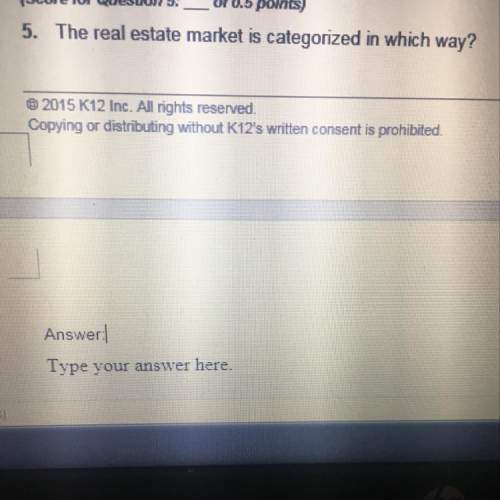
Business, 28.08.2021 05:40 meaghangreenwa
Following is information on an investment considered by Hudson Co. The investment has zero salvage value. The company requires a 6% return from its investments.
Investment A1
Initial investment $ (300,000 )
Expected net cash flows in year:
1 110,000
2 106,000
3 87,000
Compute this investment’s net present value. (PV of $1, FV of $1, PVA of $1, and FVA of $1) (Use appropriate factor(s) from the tables provided. Round all present value factors to 4 decimal places.)
Cash Flow Present Value of 1 at 6% Present Value
Year 1
Year 2
Year 3
Totals $0 $0
Amount invested
Net present value $0
Assume that instead of a zero salvage value, as shown above, the investment has a salvage value of $21,500. Compute the investment's net present value. (PV of $1, FV of $1, PVA of $1, and FVA of $1) (Use appropriate factor(s) from the tables provided. Round all present value factors to 4 decimal places.)
Cash Flow Present Value of 1 at 6% Present Value
Year 1
Year 2
Year 3
Totals $0 $0
Amount invested
Net present value $0

Answers: 2


Another question on Business

Business, 22.06.2019 10:40
You were able to purchase two tickets to an upcoming concert for $100 apiece when the concert was first announced three months ago. recently, you saw that stubhub was listing similar seats for $225 apiece. what does it cost you to attend the concert?
Answers: 1

Business, 23.06.2019 01:20
Suppose that fizzo and pop hop are the only two firms that sell orange soda. the following payoff matrix shows the profit (in millions of dollars) each company will earn depending on whether or not it advertises: pop hopadvertise doesn’t advertisefizzo advertise 10, 10 18, 2doesn’t advertise 2, 18 11, 11for example, the upper right cell shows that if fizzo advertises and pop hop doesn't advertise, fizzo will make a profit of $18 million, and pop hop will make a profit of $2 million. assume this is a simultaneous game and that fizzo and pop hop are both profit-maximizing firms.if fizzo decides to advertise, it will earn a profit if pop hop advertises and a profit if pop hop does not advertise.if fizzo decides not to advertise, it will earn a profit if pop hop advertises and a profit if pop hop does not advertise.if pop hop advertises, fizzo makes a higher profit if it chooses (not to advertise, to .if pop hop doesn't advertise, fizzo makes a higher profit if it chooses (not to advertise, to . suppose that both firms start off not advertising. if the firms act independently, what strategies will they end up choosing? fizzo will choose to advertise and pop hop will choose not to advertise.both firms will choose to advertise.fizzo will choose not to advertise and pop hop will choose to advertise.both firms will choose not to advertise.again, suppose that both firms start off not advertising. if the firms decide to collude, what strategies will they end up choosing? fizzo will choose not to advertise and pop hop will choose to advertise.both firms will choose not to advertise.fizzo will choose to advertise and pop hop will choose not to advertise.both firms will choose to advertise.
Answers: 2

Business, 23.06.2019 03:30
Jiffy printing shops does a lot of printing job for college students. the shop use an average of 25 cases of copy paper each day during the 312 days last year. the shop opens 6 days a week for 52 weeks each year and closes on sundays. each case of paper costs $35. it conducts a count of its paper inventory at the end of every quarter of the year. the table below shows the inventory counting records for last year. inventory end of quarter 1 700 cases end of quarter 2 1,050 cases end of quarter 3 920 cases end of quarter 4 800 cases 1. what's jiffy's cost of goods sold last year? 2. what's jiffy's average aggregate inventory value? 3. what's jiffy's inventory turnover last year? 4. what is the printing shop's weeks of supply last year?
Answers: 2

Business, 23.06.2019 10:00
Can you with personal finance homework1 abbreviation of annual percentage rate which the interest rate is applied annually to a loan or a credit card balance2 abbreviation of annual percentage yield the rate of return earn in the course of one whole year taking compounding into amount expressed as a percentage3 cash and other liquid assets such as demand deposits or treasury bills than individual possesses4 an expense that does not vary from one time period to the next5 to obtain a new loan for something on different terms often involving the pain off of an existing high-interest loan by means of a new lower interest one6 money set aside for future use7 to take money out of an account8 to plan the allocation expenditure or use of money9 the amount of money spent on food clothing and other basic necessities10 the amount of money that is anticipated to be received over a. of time either as payment for work goods or services or as profit on capital
Answers: 2
You know the right answer?
Following is information on an investment considered by Hudson Co. The investment has zero salvage v...
Questions

Mathematics, 20.04.2020 21:37

Mathematics, 20.04.2020 21:37


Mathematics, 20.04.2020 21:37

Mathematics, 20.04.2020 21:37

Computers and Technology, 20.04.2020 21:37

English, 20.04.2020 21:37








Mathematics, 20.04.2020 21:37

Mathematics, 20.04.2020 21:37



Health, 20.04.2020 21:37





